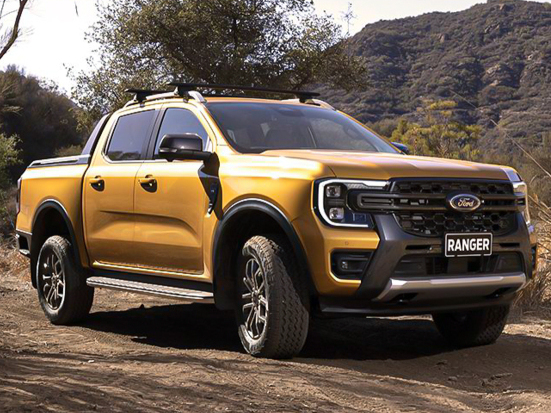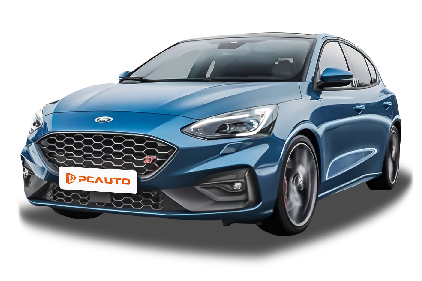Q
Which is faster? Focus ST or RS?
The Focus RS is faster than the Focus ST. The Focus ST is equipped with a 2.0-liter turbocharged engine, delivering a maximum horsepower of 250. Its official 0-100 km/h acceleration time is 6.5 seconds, and the top speed is 248 km/h. The Focus RS, however, features a 2.3-liter turbocharged engine, generating a maximum horsepower of 350. It accelerates from standstill to 100 km/h in just 4.7 seconds, with a top speed of 266 km/h. The drivetrain configuration also impacts speed performance. The Focus ST utilizes front-wheel drive, whereas the Focus RS employs all-wheel drive. All-wheel drive continuously delivers power to all four wheels, enhancing traction and stability, thereby contributing to faster speed. Furthermore, the Focus RS has more aggressive suspension and chassis tuning, along with a sport package. These combined factors give the Focus RS a distinct speed advantage over the Focus ST.
Special Disclaimer: This content is published by users and does not represent the views or position of PCauto.
Related Q&A
Q
How many gears does a Focus ST have?
The Ford Focus ST sold in the Malaysian market comes equipped with a 2.3L EcoBoost turbocharged engine paired with a 7-speed automatic transmission with SelectShift, as opposed to a traditional dual-clutch or manual gearbox (a 6-speed manual option is available in some markets). This transmission offers flexible shifting control, allowing for manual mode engagement via steering wheel paddles, optimizing both power delivery and fuel efficiency (official figures are around 7.6L/100km).
Additionally, its performance-oriented tuning maximizes the engine's 280PS power and 420Nm torque, making it particularly well-suited for Malaysia’s winding roads and highways. It's worth noting that Ford has not introduced the latest Focus ST manual version in Malaysia, so consumers seeking pure driving enjoyment may need to consider parallel imports. Moreover, this transmission features Adaptive Shift Scheduling technology, which automatically adjusts shift logic based on driving style.
Q
Which model of Ford Focus is the most fuel-efficient ?
In terms of fuel efficiency, the three-cylinder Focus is relatively economical. It features advanced fuel injection technology and a lightweight design that enables precise control of fuel injection, promoting more complete combustion. The small displacement engine strikes a good balance between power demand and fuel consumption in urban driving conditions, and it can automatically adjust its operating mode. Additionally, the lighter body reduces the energy consumption required for the engine to drive the vehicle, with a combined fuel consumption typically ranging from 5.5L to 7.0L per 100km.
On the other hand, the 2014 Ford Focus ST 2.0 Ecoboost excels in power output efficiency. With a 2.0-liter engine that produces a maximum of 253PS, it can accelerate from 0 to 100km/h in just 6.5 seconds, showcasing outstanding performance in power delivery. However, its official combined fuel consumption stands at 7.2L/100km. Therefore, those prioritizing fuel economy might consider the three-cylinder Focus, while the ST version is more suitable for those seeking power efficiency.
Q
Does the Ford Focus ST feature AWD?
The Ford Focus ST is not AWD (All-Wheel Drive). It comes with Front Wheel Drive (FWD). This means that the power from the engine is sent directly to the front wheels. FWD is a common drivetrain layout, often chosen for its simplicity, cost-effectiveness, and decent traction in many driving conditions. The 2014 Ford Focus ST 2.0 Ecoboost with its front-wheel drive setup can provide good handling and performance on regular roads. It's important to note that while AWD can offer enhanced traction in challenging terrains like snow, mud, or on uneven surfaces, the FWD in the Focus ST is designed to optimize performance and fuel efficiency in locally normal driving scenarios.
Q
Does the Focus ST have a belt or chain?
The 2014 Ford Focus ST 2.0 Ecoboost uses a timing chain instead of a belt. Both timing chains and belts are used to drive the engine's valve train, ensuring that the intake and exhaust valves open and close at the appropriate times to allow the engine to inhale and exhale properly. However, there are differences between the two. Timing chains are more durable. Their service life usually depends on the vehicle maintenance conditions. Under normal circumstances, their lifespan can reach 100,000 kilometers or more, and they generally don't require regular replacement. On the other hand, timing belts have a relatively shorter lifespan. Typically, they need to be replaced after driving approximately 60,000 kilometers. Otherwise, it may cause the engine to malfunction. Thus, the Focus ST offers relatively straightforward maintenance for its timing system, allowing owners to avoid concerns about replacing timing belts after a certain mileage.
Q
What is the fuel efficiency of Ford Focus ST ?
2014 Ford Focus ST 2.0 EcoBoost has an official combined fuel consumption of 7.2L per 100km. Whether it's fuel-efficient depends on various factors and which model you compare it to. For a performance-oriented vehicle with 253 horsepower, this figure is relatively decent. It indicates that under normal driving conditions, it can maintain a certain level of fuel efficiency while still delivering strong acceleration capabilities.
However, if compared to some small, fuel-efficient city cars, the consumption might appear higher. Additionally, actual fuel consumption can vary significantly based on driving habits, road conditions, and vehicle load. Aggressive driving with frequent hard acceleration and braking will likely increase fuel consumption, while a more conservative and steady driving style may result in figures closer to the official data. Overall, it strikes a balance between performance and reasonable fuel consumption.
Q
How long can the engine of the Ford Focus ST last?
With proper maintenance and normal usage, the engine of the Ford Focus ST is typically expected to last over 600,000 kilometers, potentially exceeding 20 years. Ford has tested its next-generation ECOBOOST engine, which showed almost no significant signs of aging after 400,000 kilometers of operation, demonstrating impressive durability. However, the actual lifespan of the engine can be influenced by various factors.
In terms of driving habits, aggressive acceleration, hard braking, and prolonged high-load operations can increase engine wear and shorten its lifespan. Regarding component quality, using subpar engine oil, air filters, and other parts can hinder the engine's performance and longevity. Additionally, maintenance practices play a crucial role; irregular servicing and failing to timely replace oil and wear-and-tear parts can negatively impact the engine's long-term stability and operation.
Q
How big is a gas tank in Focus ST ?
The 2014 Ford Focus ST 2.0 EcoBoost features a fuel tank capacity of 55 liters. This substantial fuel storage capacity is beneficial as it allows the vehicle to achieve a notable range between fill-ups, catering to various driving needs, whether for daily commutes or long road trips. A larger fuel tank like this means fewer trips to the gas station during travels, providing added convenience for drivers. It gives you more flexibility on the road without the constant worry of running out of fuel too soon. This tank capacity is comparable to many other vehicles in its class, ensuring that the Focus ST can cover a considerable distance before needing to refuel.
Q
How reliable is Focus ST?
The Focus ST boasts a commendable level of reliability. In terms of chassis and suspension, it features dual-adjustable dampers, a double-tube stainless steel shock absorber casing, and powder-coated springs. The meticulously tuned chassis offers excellent stability, while the suspension system lowers the vehicle’s body height and can be adjusted to reduce unsprung weight, enhancing driving stability.
On the powertrain front, the equipped turbocharged 2.3-liter EcoBoost engine delivers consistent output with impressive torque characteristics. The 6-speed manual transmission offers quick and responsive shifts, providing an engaging driving experience. Inside, the cabin is well-appointed and reliable, featuring seats made from a blend of black leather and Alcantara materials, while the B&O sound system delivers an exceptional audio experience.
In terms of design, the RS-style classic Racing Blue paint job paired with high-gloss black accents creates an attractive yet durable exterior. Whether for daily commuting or more spirited driving, the Focus ST demonstrates high reliability through these outstanding attributes, giving owners worry-free driving experience.
Q
Does a Focus ST have a launch control system?
The 2014 Ford Focus ST 2.0 EcoBoost does not explicitly list a launch control system among its features. However, some other Ford Focus models have demonstrated support for a "launch assist" function in various tests. For instance, certain evaluations of the Focus revealed that the car could achieve a controlled launch. Yet, for this specific 2014 Focus ST, we cannot determine whether it is equipped with a traditional launch control system without official confirmation.
Launch control can optimize and stabilize acceleration from a standstill by precisely managing engine power, torque, and transmission engagement. While the Focus ST comes with a robust 2.0-liter engine that produces 253 horsepower and can accelerate from 0 to 100 km/h in 6.5 seconds, it likely lacks the specialized launch control feature found in some high-performance vehicles.
Q
How much horsepower can a Focus ST handle?
The horsepower that the Focus ST can withstand varies depending on the model version. For example, the 2014 Focus ST 2.0 Ecoboost has a maximum engine horsepower of 253 PS. The new Focus ST Edition special edition is equipped with an EcoBoost 2.3-liter inline 4-cylinder turbocharged gasoline engine, with a maximum output of 280 hp. Different engine tunings and technical applications result in varying horsepower performance across models. Higher horsepower delivers stronger power output, providing advantages in acceleration and overtaking. For instance, the 280-horsepower version accelerates from 0 to 100 km/h in just 5.7 seconds, with a top speed of 250 km/h, offering a more thrilling driving experience. However, during actual driving, it's essential to properly utilize the vehicle's horsepower by considering overall performance and road conditions to ensure safe operation.
Popular Cars
Model Year
Car Compare
Car Photo
Latest Q&A
Q
How much did a new 2018 beetle cost?
The 2018 Volkswagen Beetle had a starting price range of approximately RM120,000 to RM180,000, depending on the trim and options. The entry-level 1.2 TSI Design model was the most affordable, while the top-spec 2.0 TSI R-Line version approached RM180,000—though final pricing could vary with optional extras and dealer promotions.
As a timeless classic, the 2018 Beetle kept its retro charm but packed modern tech like a touchscreen infotainment system and active safety features. Under the hood, buyers could choose between the fuel-efficient 1.2T or the more spirited 2.0T engine.
Fair warning: Volkswagen discontinued the Beetle in 2019, so you’ll only find it on the used market now. That said, its iconic design and nostalgic appeal still make it a hit among collectors. If you’re eyeing a pre-owned model, always check the vehicle history and maintenance records to snag a solid deal.
Q
What engine does a 2018 VW Beetle have?
The 2018 Volkswagen Beetle offered two gasoline engine options across different markets. The primary powerplant was a 1.2-liter TSI turbocharged inline-four, delivering 105 horsepower and 175 Nm of torque, paired with a 7-speed DSG dual-clutch transmission. This compact forced-induction engine struck a balance between urban fuel efficiency and strong low-end torque.
Higher-spec variants featured an optional 1.4-liter TSI turbocharged unit, bumping output to 150 horsepower. Both engines adopted direct fuel injection and belonged to VW’s widely used EA211 modular family, featuring modern tech like lightweight aluminum blocks.
Though retaining its iconic silhouette, this generation Beetle actually shared its underpinnings with the Golf, inheriting the brand’s proven front-wheel-drive architecture. This platform commonality also translated to easier maintenance, as local dealerships were well-versed in servicing these powertrains thanks to extensive parts sharing across VW’s lineup.
Q
What are the different models of the 2018 VW Beetle?
The 2018 Volkswagen Beetle comes in three main trims: Classic, Trendline, and Sport. All models are powered by a 1.2-liter TSI turbocharged engine delivering 105 horsepower, paired with a 7-speed DSG dual-clutch transmission—perfect for city driving with its nimble handling and solid fuel efficiency.
The entry-level Classic trim rolls on 16-inch wheels and features a basic multimedia system. Stepping up to the Trendline adds 17-inch wheels, fog lights, and chrome accents. The Sport trim leans into its name with 18-inch wheels, a sport-tuned suspension, and unique interior color options.
This generation keeps the Beetle’s iconic retro curves but modernizes them with touches like LED daytime running lights. Inside, you’ll find color-matched dash panels, and with 310 liters of trunk space, it’s more practical than most small cars in its class.
Since the Beetline was discontinued in 2019, the 2018 model stands as the last new generation, making it a rising collector’s item—especially the convertible, which holds strong appeal in the used market. For maintenance, stick to routine service every 15,000 km or 12 months, and regular 95-octane fuel is all it needs.
Q
Does the 2018 Beetle have Apple CarPlay?
The 2018 Volkswagen Beetle did come equipped with Apple CarPlay, integrated into its Composition Media infotainment system. This allowed iPhone users to seamlessly connect for navigation, music, and other apps. The system also supported Android Auto, catering to different smartphone users with its intuitive and responsive interface—definitely a plus for convenience on the road.
That said, some early-production 2018 models might require a software update to activate the feature, so it’s worth checking with an official dealer to confirm your car’s specs or available upgrades. Also, wireless Apple CarPlay wasn’t standard across all trims; it depended on the factory-installed options.
For fans of classic styling who still want modern tech, the Beetle struck a nice balance between retro charm and everyday usability. Competitors like the Mini Cooper offered similar connectivity, but let’s be honest—the Beetle’s iconic design was always its standout feature.
Q
What is the fuel economy of the 2018 Beetle?
The 2018 Volkswagen Beetle's fuel efficiency varies by powertrain. The 1.2L TSI turbocharged version delivers a combined fuel consumption of around 5.5L/100km, while the 1.4L TSI model is slightly thirstier at approximately 6.0L/100km – both perform best with 95-octane petrol.
You'll likely see higher consumption in city driving, but it cruises efficiently on highways thanks to its classic aerodynamic design. For better mileage, stick to routine maintenance like cleaning the air filter and keeping tyres properly inflated. These small habits can help squeeze out extra kilometres per litre.
Though discontinued, the 2018 Beetle remains popular in the used car market – its iconic styling and decent fuel economy make it a practical daily driver. Just remember real-world figures depend heavily on driving style and road conditions, so check owner forums for real-life feedback.
View MoreRelated News

Ford Focus is about to cease production in November and may return in 2027 in the form of an SUV.
WilliamSep 15, 2025

2025 Ford Ranger WildTrak launched, the most powerful diesel version in the Ranger lineup
MichaelAug 25, 2025

Is the Ford Ranger V6 about to enter Malaysia?
LienAug 13, 2025

Reviewing the Ford Ranger: The Dual Advantages of Rugged Appearance and Powerful Performance
Kevin WongApr 21, 2025

Ford Unveils “Simulated Manual Transmission” Patent to Reignite Driving Pleasure in Electric Vehicle
LienApr 2, 2025
View More


















Pros
Cons